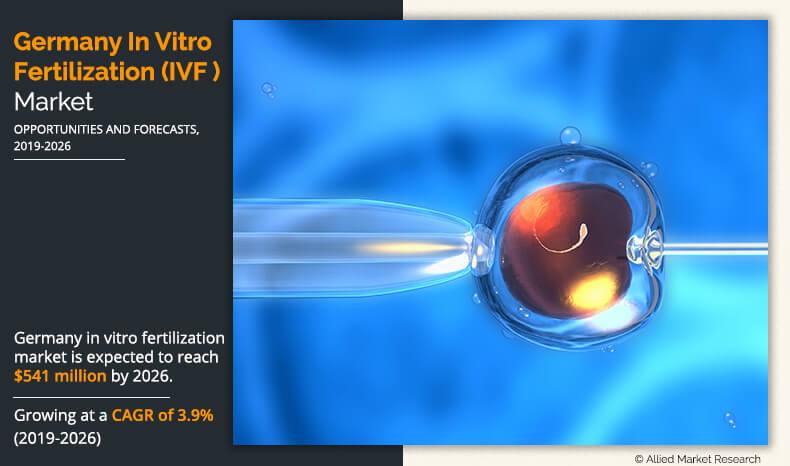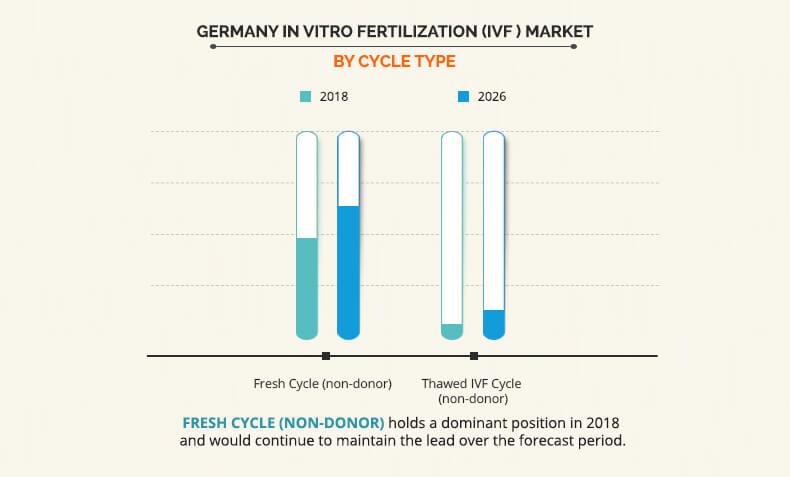Germany IVF Market Outlook - 2026
The Germany IVF market was valued at $398 million in 2018 and is estimated to reach $541 million by 2026, registering a CAGR of 3.9% during the analysis period.
In vitro fertilization (IVF) is a process that involves artificial fertilization of extracted egg cells by sperm in a laboratory dish. The retrieved eggs are placed in a petri dish along with sperm that are specially washed. This results in the fertilization process which in turn leads to the formation of embryos. These embryo are then transferred to a woman's uterus for implantation. IVF is employed in patients with tubal sterility, idiopathic infertility, male fertility and others. Moreover, the technique is also employed in the treatment for genetic problems. The in vitro fertilization process is used when less expensive or invasive options such as fertility drugs to increase production of intrauterine insemination or eggs have failed.
The factors that propel the Germany IVF market include, trend of delayed marriages in the country. This trend has led to rise in number of infertility cases as the problem of infertility is directly related to rise in age. Moreover, factors such as parenthood decisions, subsidizing IVF treatments, and surge in prevalence of infertility issues are the factors that majorly drive the growth of the Germany IVF market. In addition, as per National Health Plan (NHP), about 50% of the treatment cost by IVF paid for three cycles is anticipated to drive the IVF market in Germany. However, stringent government regulations, and lack of availability in treatment cycles for IVF are the major restraints expected to hinder the growth of the market in Germany.
Germany In Vitro Fertilization Market Segmentation
The Germany in vitro fertilization market is segmented based on cycle type and end user. Based on cycle type, the market is segmented into fresh IVF cycles (non-donor) and thawed IVF cycles (non-donor). Based on end user, the market is divided into fertility clinics, surgical centers, hospitals, and clinical research institutes.
Segment review
Based on cycle type, the Germany in vitro fertilization market is divided into fresh IVF cycles (non-donor) and thawed IVF cycles (non-donor). The fresh embryo IVF cycle begins with the ovarian stimulation, which is followed by retrieval of all eggs from the patient. These eggs are reinserted to create an embryo; these embryos are transferred back in the patient. Any remaining good quality embryos are frozen, which can be used in the future frozen IVF cycles. The fresh IVF cycles acquired the largest Germany in vitro fertilization market share in 2018 as fresh IVF cycle is more stable and has better outcomes when compared to other techniques. Furthermore, thawed IVF cycles is expected to grow with fastest rate during the forecast period owing to the surge in infertility in the region coupled with the increase in number of IVF clinics.
According to end user, the Germany in vitro fertilization market is classified into fertility clinics, hospitals, surgical centers, and clinical research institutes. Fertility clinics play a crucial role in providing IVF treatments to couples seeking assistance for infertility treatments. These provide technologically advanced IVF treatments to patients with fertility problems. The fertility clinics in the end user segment generated the highest revenue in 2018. The fertility clinics segment is the largest and the fastest segment during the forecast period owing to presence of large number of fertility clinics, which are projected to rise further during the forecast period.
The major companies profiled in this report include Heidelberg University Hospital, Klinikum Stuttgart, DRK Kliniken Berlin, and University Medical Center Freiburg.
Key Benefits for Germany In Vitro Fertilization Market:
- This report entails a detailed quantitative analysis along with the current Germany in vitro fertilization market trends of the market from 2018 to 2026 to identify the prevailing opportunities along with the strategic assessment of the market.
- The Germany IVF market forecast is studied from 2019 to 2026.
- The Germany IVF market size and estimations are based on a comprehensive analysis of key developments in the in vitro fertilization (IVF) industry.
- A qualitative analysis based on innovative products facilitates strategic business planning.
- The development strategies adopted by the key market players are enlisted to understand the competitive scenario of the market
Germany In Vitro Fertilization (IVF) Market Report Highlights
| Aspects | Details |
| By GERMANY IN VITRO FERTILIZATION (IVF) MARKET |
|
| Key Market Players | VivaNeo Deutschland GmbH, Heidelberg University Hospital, Praxis fur fertilitat, Klinikum Stuttgart, DRK Kliniken Berlin, University Medical Center Freiburg |
Analyst Review
In vitro fertilization (IVF) is a process of fertilization in which the eggs are extracted, sperm sample is retrieved, and then the egg and sperm are allowed to fertilize together in a laboratory dish. It is a type of assisted reproductive technology which help women conceive. It is mostly performed when other, less expensive, or invasive fertility techniques have failed. The 5 steps of the IVF and embryo transfer include fertility medication, eggs retrieval through minor surgery, sperm collection, insemination, and embryo culture & transfer.
The utilization of in vitro fertilization for Germany is expected to witness significant growth, owing to delayed marriages and parenthood decisions, subsidizing IVF treatments, and surge in prevalence of infertility issues. In addition, as per National Health Plan (NHP), about 50% of the treatment cost by IVF paid for three cycles is anticipated to drive the growth of the IVF market in Germany.
According to cycle type, the fresh IVF cycles acquired the largest share in Germany for in vitro fertilization market in 2018. Better outcomes and more stability offered by the technique are responsible for the growth of the market. Similarly, based on end user, the fertility clinics segment generated the highest revenue in 2018 owing to presence of large number of fertility clinics during the forecast period.
Loading Table Of Content...





